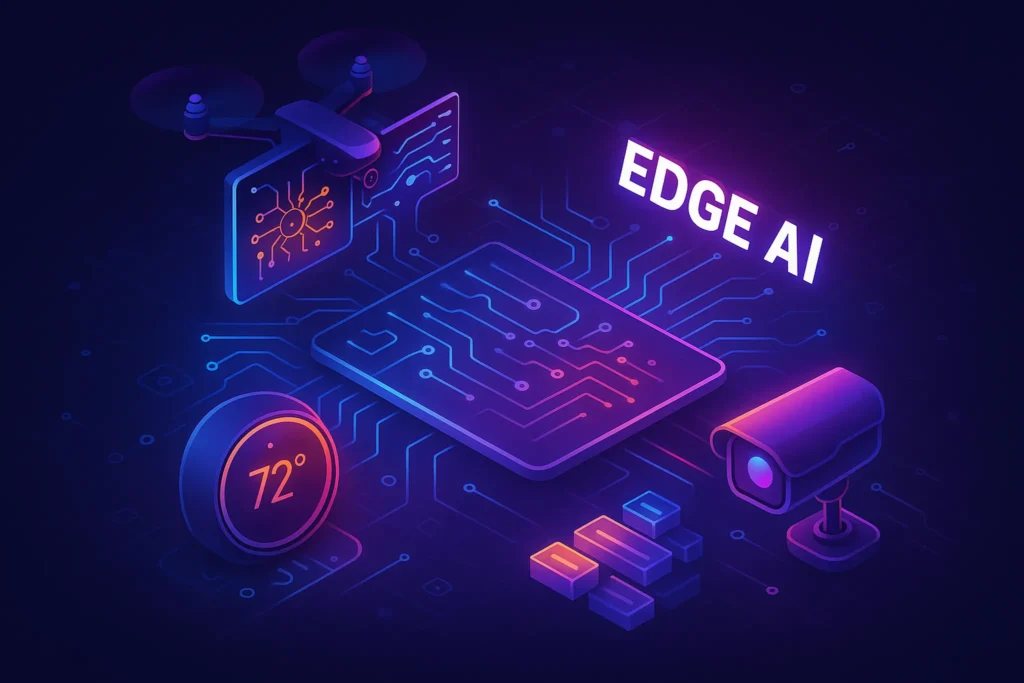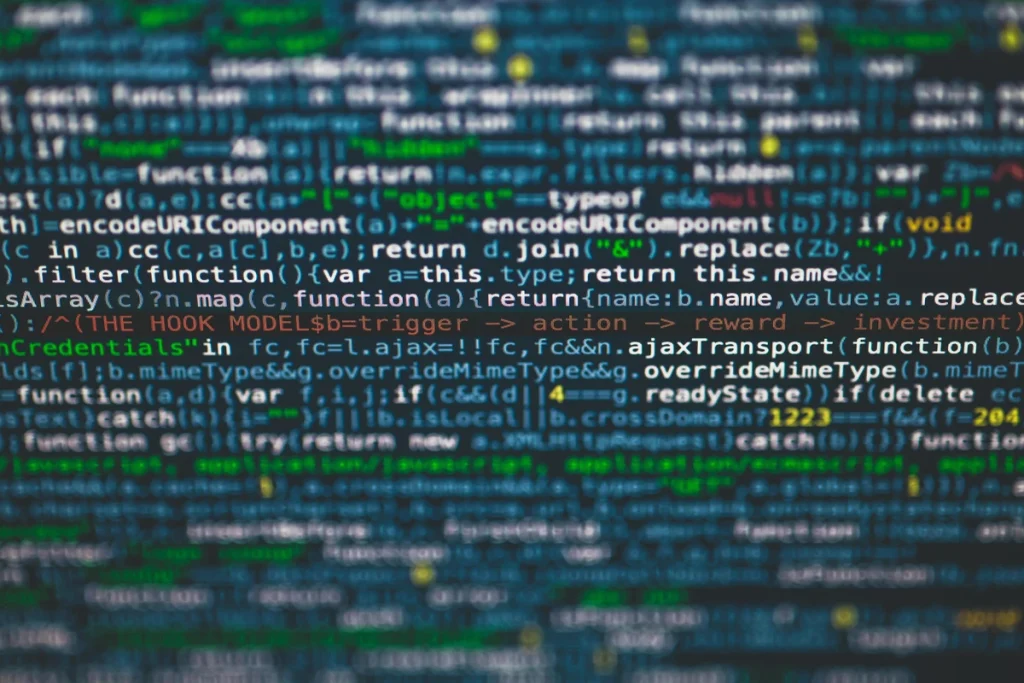🤖 What If Your Gadgets Got Smarter—Without the Cloud?
Imagine a world where your doorbell camera doesn’t just record motion—it recognizes the person at your door instantly, without sending any data to a cloud server.
Or think about a drone that can detect obstacles, track objects, and respond in real time—even in areas with no internet.
Welcome to the age of Edge AI—where artificial intelligence lives not in distant data centers, but right inside the devices we use every day.
Whether it’s your smart thermostat predicting your preferences or a warehouse robot detecting anomalies on-site, Edge AI is changing how machines “think” and act—locally, fast, and often more privately.
In this guide, we’ll unpack what Edge AI is, how it differs from traditional cloud-based AI, and explore the exciting ways it’s being used in smart homes, industrial settings, healthcare, and beyond.
🧠 What Is Edge AI, Exactly?
At its core, Edge AI refers to the execution of artificial intelligence algorithms directly on local hardware—often on IoT (Internet of Things) devices—rather than relying on a centralized server or cloud infrastructure.
Instead of sending data to a data center for processing, these devices:
-
Capture the data (like video or sensor input)
-
Process it locally
-
Make decisions on the spot
This creates faster response times, minimizes bandwidth usage, and in many cases, enhances user privacy since sensitive data doesn’t need to leave the device.
☁️ Cloud AI vs Edge AI: What’s the Difference?
| Feature | Cloud AI | Edge AI |
|---|---|---|
| ⚙️ Processing | Done on remote servers | Done on the device itself |
| 📶 Latency | Higher (depends on internet speed) | Very low (real-time capable) |
| 🔐 Privacy | Data travels over the internet | Stays local (more secure) |
| 🌐 Dependency | Requires internet connectivity | Works even offline |
| 🧠 Use Cases | Deep learning, complex ML training | Real-time inference, quick decisions |
Think of Cloud AI as the “brain in the cloud” and Edge AI as the “reflex in the device.”
🔗 For more on how AI is blending into daily life, check out our post on AI in Everyday Life or explore how AI Assistants Can Handle Your Daily Tasks right from your phone or smart speaker.
⚡ Why Edge AI Matters: Real-World Benefits
While cloud computing revolutionized how we train and scale machine learning, Edge AI represents a new frontier: one where responsiveness, privacy, and reliability come first.
Here’s why Edge AI is gaining traction across industries:
🕒 1. Ultra-Low Latency
When devices can process data locally, they respond faster. Think:
-
Drones navigating obstacles in real-time
-
Autonomous vehicles making split-second decisions
-
Security cameras instantly flagging threats
This isn’t just convenience — in some industries, milliseconds can save lives or prevent disasters
🧠 You can read more about how AI boosts productivity in fast-response environments in our post on How AI is Transforming Productivity.
📡 Want More Future-Ready Tech Like This?
Join our free newsletter for weekly deep dives into emerging technologies, AI-powered tools, and smart systems that will shape the next decade.
Whether you’re building products or just staying ahead of the curve—this is for you.
🔐 Zero hype. Just practical breakdowns and future-focused insights from the team at NerdChips.
🔐 2. Enhanced Privacy & Data Control
Edge AI helps reduce the need to transmit sensitive data—like your voice, face, or home activities—to third-party cloud providers.
-
Smart speakers that process voice commands on-device
-
Health monitors that keep biometric data local
-
Retail stores using edge analytics to monitor foot traffic without recording identities
This shift aligns with growing concerns over digital privacy and regulatory pressure like GDPR or CCPA.
Related: Our piece on AI in Everyday Life explores more on the privacy-first movement in consumer tech.
🌍 3. Always Available, Even Offline
With cloud AI, an internet outage can break your smart system. But Edge AI devices continue working — even without a connection.
Ideal for:
-
Remote farms using AI for crop monitoring
-
Field operations or military zones
-
Disaster zones or developing regions
This offline reliability is what makes Edge AI critical for industrial IoT, smart grids, and healthcare-in-the-field setups.
📉 4. Lower Bandwidth and Cloud Costs
Constantly uploading data to the cloud can be expensive and inefficient. Edge AI reduces cloud dependency by:
-
Processing bulk data locally
-
Sending only essential summaries or alerts
This benefit is especially important in smart cities, where thousands of cameras, meters, and sensors operate simultaneously.
Want to see how edge devices simplify modern life? Don’t miss Simplify Your Life with IoT — our practical guide to the smart tools of 2025.
🏗️ Real-World Applications of Edge AI
Edge AI isn’t just a theoretical breakthrough—it’s already being used across industries to make machines smarter, faster, and more autonomous.
Let’s break down some of the most exciting use cases:
🏠 1. Smart Homes & Consumer Devices
Edge AI makes your smart home smarter—without the lag or privacy risks of the cloud.
Examples:
-
Video doorbells like Google Nest Cam can recognize familiar faces and alert you instantly.
-
Thermostats like Ecobee or Nest adjust heating based on behavior patterns—without uploading constant data.
-
Voice assistants (Amazon’s AZ1 chip or Apple Neural Engine) now process queries locally, boosting speed and privacy.
These are the same systems we covered in AI in Everyday Life—but with edge optimization, they’ve become faster, quieter, and more privacy-conscious.
🚗 2. Autonomous Vehicles
Self-driving cars and drones rely heavily on Edge AI for:
-
Obstacle detection
-
Real-time navigation
-
Sensor fusion (combining lidar, radar, and vision)
Platforms like NVIDIA Jetson or Qualcomm Snapdragon Ride are engineered to handle heavy ML tasks on the edge without waiting for cloud signals.
🏥 3. Healthcare & Wearables
Medical-grade wearables and diagnostic tools are embracing Edge AI to:
-
Monitor vitals like heart rate, oxygen, and motion
-
Detect anomalies like arrhythmia in real time
-
Operate in remote areas without needing stable internet
Devices like the Apple Watch Series 9, Oura Ring, and hospital tools from GE Healthcare are all exploring on-device AI processing.
👉 Related: See how tools like these are part of the broader revolution in How AI is Transforming Productivity.
🏭 4. Industrial Automation & Manufacturing
In factories, downtime = money lost. Edge AI enables:
-
Predictive maintenance by analyzing machinery vibrations/sounds
-
Computer vision for quality inspection
-
Smart robotics that react to changes in assembly lines
Edge-powered platforms like Amazon Panorama, Siemens MindSphere, or Azure Percept let companies deploy AI without needing full-blown cloud infrastructure.
📹 5. Surveillance & Security
Security cameras now come with on-device person detection, behavior modeling, and facial recognition:
-
Retail: Analyze customer movement without recording identities
-
Airports: Flag suspicious patterns or abandoned luggage
-
Corporate buildings: Authenticate employees via facial match
Platforms like Hikvision DeepinMind and Google Coral Dev Board are pushing AI to the edge of visual analytics.
Bonus: Check out How AI Assistants Can Handle Your Daily Tasks to see how these tools play a part in automating even mundane decisions.
🔁 Hybrid AI Models: Edge + Cloud Together
Many real-world systems use a hybrid approach where edge handles real-time decisions, and cloud supports broader model updates.
- Federated Learning: Models are trained across devices without sharing raw data.
- Cloud Assist: Cloud helps with deeper analytics while the edge handles fast actions.
💻 Hardware That Powers Edge AI
| Platform | Best For | Language Support | Edge Accelerator | Notes |
|---|---|---|---|---|
| Jetson Nano | DIY & robotics | Python, C++ | GPU | Open source models |
| Coral Dev Board | Real-time vision | TensorFlow Lite | Edge TPU | Low power usage |
| Raspberry Pi + HAT | Beginners | Python | Optional | Flexible but weaker |
| AWS Panorama | Enterprise video analytics | Python | Yes | Cloud-assisted hybrid |
🌱 What’s Next for Edge AI? Future Possibilities
- Smart Agriculture: Disease detection via edge cameras
- Retail Automation: Intelligent shelves with real-time tracking
- Elderly Care: Fall detection + context-aware monitoring
These are just a few frontiers where Edge AI could revolutionize everyday environments.
🧠 Nerd Verdict: Why Edge AI Is the Future You’ll Actually Use
Edge AI isn’t a far-off concept reserved for tech giants. It’s already reshaping how we interact with devices, data, and decisions — whether that’s a thermostat adjusting in real time, a security camera acting proactively, or a drone navigating autonomously.
The combination of speed, autonomy, and privacy makes Edge AI one of the most practical AI advancements of the decade — not just for industries, but for everyday life.
If you’re building smart systems, working with IoT, or just want your devices to think faster and safer — this is where your journey begins.
❓ FAQ: Nerds Ask, We Answer
💬 Would You Bite?
What’s one device in your daily life that should get smarter with Edge AI?
👇 Drop your ideas in the comments — we’d love to know where you see the potential for intelligence at the edge.



